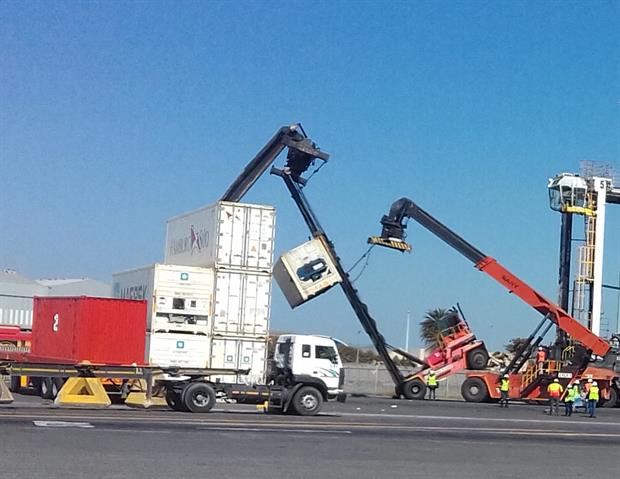 What happened? |
A couple of images are doing the rounds, showing a container handler in a precarious position at Cape Town Container Depot in August last year.
Rather than simply responding with a "WTF?" (what training flaws?),
Forkliftaction News attempted to find out the cause of the incident.
Veteran trainer and Safety First contributor Danny Marron says it's all about the centre of gravity and the "stability triangle".
"When the forklift is idle, the centre of gravity sleeps. Once the operator starts to work the lift truck, the centre of gravity springs to life. And whatever the operator does to the forklift, the centre of gravity will move in and around the triangle," he explains.
Marron adds that the centre of gravity is affected by movement, weight (load), height and tilt, and, if so equipped, reach.
"The combination of raised forks along with a heavy load will definitely result in this mishap, resulting in damage to the forklift, damage to the container and its load, possible injury to the operator; the expense and downtime not to be dismissed," he deduces.
As to the cause of the mishap, Marron speculates that one particular container may have been heavier than the rest of the containers - or beyond the lifting capacity of the particular forklift. "Why was the operator travelling with a load raised in the air when it should have been positioned closer to the ground where it belongs, and only raise the forks when ready to lift and deposit?"
Darren Cottingham, general manager of New Zealand's DT Driver Training, agrees that it is difficult to see exactly what has happened due to the distance and perspective. His guesses are that the driver has reversed too quickly with the load still raised (e.g. if the container had been taken off a stack and the driver has reversed away quickly) or that the driver has braked too hard with the load raised. "This would have happened if the driver was lifting the container while approaching the stack, rather than reaching the stack, stopping, then lifting the container."
Another possible explanation is a strong tailwind which could have pushed the centre of gravity outside the stability triangle, but Cottingham notes that "it would need a very strong wind".
Like Marron, he also cites the container being too heavy for the rated capacity of the forklift, although he feels this is unlikely because those types of containers have a maximum rated mass (24,000 kg for a 20-foot container) "and a port is unlikely to buy a machine that doesn't cover off the maximum load".
"The driver (could have) turned while the load is high - again, unlikely as this usually tips the machine sideways, not forward, plus the rear wheels look straight," he points out.
Finally, could it have been equipment failure? "I can't see how this would have happened, though, because the mast isn't broken or bent - something that would potentially move the container outside the stability triangle."
Cottingham suspects the most probable cause was the driver reversing too quickly with the load still raised, in which case, the driver should have backed away from the stack slowly, lowered the load and then continued with the manoeuvre. Drivers at ports have to assume that containers aren't overloaded as there's no way of checking their contents, he adds.
For Marron, a burning issue is the experience level of the operator.
"The forklift operator must know the lifting capabilities of the forklift. The forks (load) should be left close to the ground until such time when the operator is required to raise the forks and place the load at its intended spot," he advises. "Never drive a forklift with an elevated load." So a key lesson is to know the limitations of your forklift.
Not surprisingly, Marron concludes that 'proper training is essential".
"Not all training is the same, at least in North America. Only a well-versed operator can perform the tasks as required by the employer. Online training doesn't cut it. In-house training can be suspect."